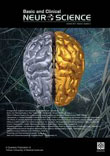فهرست مطالب

Basic and Clinical Neuroscience
Volume:2 Issue: 4, Summer 2011
- تاریخ انتشار: 1391/01/07
- تعداد عناوین: 12
-
-
Page 5IntroductionThis study was designed to investigate the effects of music in Wistar rats after sub-chronic treatment of simvastatin. The rats were orally administered with either simvastatin or saline (controls). After 4 weeks of drug treatment, the rats were selected for behavioral studies. The rats were exposed to music 24 hours before behavioral tests (Mozart’s piano sonata, KV361, Largo).ResultsThe experiments suggest that exposure to chronic treatment with simvastatin (1 or 10 mg/kg/day) reduced anxiety levels in rats when associated with Mozart music in an elevated plus-maze.DiscussionThese results indicate that music can serve as an effective adjuvant in rats treated with simvastatin, and that this species could potentially be used in other preclinical models utilizing musical interventions.
-
Page 12IntroductionSeveral studies indicate that estrogen use increase performance on some tests of cognition especially in postmenopausal women. These steroids have many side effects, thus, other estrogenic agents with fewer side effects are needed to develop alternative treatment strategies. The main objection of this study was to evaluate the effects of different doses of dietary soy meals (with or without isoflavone) on spatial learning and memory in ovariectomized (OVX) rats.MethodsFemale Wistar rats with the exception of intact group were ovariectomized at the first line of study. Subjects were divided into six groups. The control group rats (c) were gonadally intact, while the others were OVX. OVX groups received normal diet (0), treated with 10 gr soy (10), 20 gr soy (20), 10 gr isoflavone free soy (-10) or 20 gr isoflavone free soy (-20) in daily diet for four weeks. The spatial learning and memory were tested using Morris water maze. Rats were trained in water maze to find a hidden escape Platform. Rats received 6 blocks that each block consisted of 3 trials. Following acquisition trials, one probe trial were conducted in which the platform was removed.ResultsSoy meal diet (with or without isoflavone) in ovariectomized rats caused improvement of performance across 18 trials of Acquisition.DiscussionOur results suggest that soy consumption apart from containing isoflavone or not is a potential alternative to estrogen in the improvement of cognition.
-
Page 19IntroductionNucleus cuneiformis (NCF), as part of descending pain inhibitory system, cooperates with periaqueductal gray (PAG) and rostral ventromedial medulla (RVM) in supraspinal modulation of pain. Cannabinoids have analgesic effects in the PAG, RVM and NCF. The transient receptor potential vanilloid type 1(TRPV1) can be activated by anandamide and WIN55,212-2 as a cannabinoid receptor agonist. The aim of the current study is to investigate the possible interplay between the cannabinoid and vanilloid systems for modulation of pain at the NCF.MethodsIn this study, a cannabinoid receptor agonist, WIN55,212-2 (15 μg/0.3 μl DMSO), and selective TRPV1 receptor antagonist, capsazepine (10, 25, 50 and100 nmol/0.3 μl DMSO), were microinjected bilaterally into the NCF, and tail-flick and formalin tests were used to assess the animal’s pain-related behaviors at 5-min intervals for a 60-min period.ResultsOur findings demonstrated that analgesic effect of WIN55,212-2 were dose-dependently attenuated by capsazepine in both tests. In the tail-flick test, capsazepine at both doses of 50 (P<0.01) and 100 (P<0.001) nmol could significantly prevent the antinociceptive effect of WIN55,212-2 while capsazepine, in formalin test, could decreased its antinociceptive effect at the dose of 50 nmol (P<0.05) as well. On the other hand, solely administration of the highest dose of capsazepine in both tests did not alter the pain-related behaviors.DiscussionIt suggests a possible role for TRPV1 receptors in NCF-mediated cannabinoid-induced antinociception.
-
Page 27IntroductionThe role of serotonergic fibers in avoidance learning is controversial. Involvement of the dorsal raphe nucleus (DRN), the main source of hippocampal projecting serotonergic fibers in acquisition, consolidation and retrieval of passive avoidance (PA) learning, was investigated by functional suppression of this area.Materials And MethodsDRN functional inactivation was done by lidocaine (0.5μl, 2%) injection into the DRN, 5 min before training (n=10); and 5 (n=9), 90 (n=10) and 360 min (n=9) after acquisition trial. In the last experiment, lidocaine was injected into the DRN 5 min before the retrieval test, which was 48 h after the training (n=10).ResultsOur results showed that PA learning was not impaired by DRN inactivation 5 min before training nor 5 and 360 min after training. Lidocaine injected 90 min after the acquisition trial significantly reduced avoidance of the dark compartment (P<0.001). Intra-DRN injection of lidocaine before retrieval significantly increased PA retention (P<0.001). Therefore, it seems that DRN has opposite effects on consolidation and retrieval of passive avoidance learning, but it has no effect on PA acquisition.DiscussionIt is suggested that functional ablation of DRN may disrupt integrity of subcortical circuits participating in PA consolidation, but DRN inactivation by increasing brain awareness may affect PA retrieval in rats.
-
Page 36Effects of intra-central amygdala administration of L-arginine, a nitric oxide precursor, and NG-nitro-L-arginine methyl-ester (L NAME), a nitric oxide synthase inhibitor, on the morphine-induced sensitization and also on the expression of morphine-induced place conditioning in rats were studied. Subcutaneous (s.c.) administration of morphine (2.5, 5 and 7.5 mg/kg) induced place conditioning. Repeated pretreatment of morphine (5 mg/kg, i.p.) followed by 5 days no drug treatment, increased place conditioning induced by morphine (0.5 mg/kg). Repeated intra-central amygdala administration of L-arginine (0.3, 1 and 3 μg/ rat), with morphine during acquisition of sensitization, significantly increased or reduced morphine place conditioning in sensitized rats. The drug administration before testing also increased and reduced the expression of morphine place conditioning in sensitized animals. Repeated intra-central amygdala injections of L-NAME (0.3, 1 and 3 μg/rat) with morphine during acquisition of sensitization, reduced the acquisition of morphine place conditioning in the sensitized animals. The drug injection before testing also reduced morphine-induced conditioning. The results indicate that nitric oxide (NO) within the central amygdala may be involved in the acquisition and expression of morphine place conditioning in morphine-sensitized rats.
-
Page 47IntroductionThe role of ovarian hormones and nitric oxide (NO) in learning and memory and their interaction has been widely investigated. The present study carried out to evaluate different effect of L-NAME on spatial learning and memory of ovariectomized (OVX) and sham operated rats.Methods32 rats were divided into 4 groups: 1) Sham; 2) OVX; 3) Sham-LN; and 4) OVX-LN. The animals of groups 3 and 4 were treated by L-NAME (10 mg/kg/ day) for 8 weeks while the animals of groups 1 and 2 received saline (1ml/kg/day) instead of L-NAME. The animals of all groups were then tested in Morris water maze during five days. The escape latency and traveled distance were compared between groups.ResultsDistance and time in OVX group was significantly higher than Sham group (p<0.01 and p<0.05). Time and distance in Sham-LN group was higher in comparison with Sham group (p<0.05 and p<0.01). There were no significant differences between OVX-LN and OVX groups in escape latency and traveled distance.DiscussionThe results of present study showed that removal of ovarian hormones could impair Morris water maze tskas includiong time and distance. Administarion of non specific nitricoxide inhibitor, L-NAME, affects Morrsi water maze tasks however, its effect is different in the absence and presence of ovarian hormones but it needs to be more investigated.
-
Page 53IntroductionSildenafil, a phosphodiesterase-5 (PDE5) inhibitor, may have various effects on the central nervous system via the nitric oxide (NO)-cyclic guanosine monophosphate (cGMP) pathway. Preclinical studies have shown the controversial effect of sildenafil on anxiety-like behavior in animals. This study was undertaken to investigate the acute effect of sildenafil on anxiety-like behavior in mice.MethodsMale mice were intraperitoneally (i.p.) administrated sildenafil (1, 2, or 10 mg/kg), and the control group was given the vehicle 15 min before the plus-maze test. The number of entries into the open arms of the plus-maze, the time spent in the open arms, and the total numbers of entries into the arms were recorded.ResultsThe results indicated that compared to the control group, the sildenafil-treated mice spent more time in the open arms and had a greater number of entries into open arms. The total number of entries into the arms did not significantly differ between the sildenafil-treated groups and the control group.DiscussionAcute administration of sildenafil could have anxiolytic effects on male mice. This effect might be mediated in a time-dependent manner by the NO/ cGMP/PDE5 pathway.
-
Page 58Reconsolidation memory is defined as a process in which the retrieval of a previously consolidated memory returns to a labile state which is then subject to stabilization. Previous studies have shown that mineralocorticoid receptors (MRs) modulate distinct phases of learning and memory, which display a high concentration and distinct distribution in the hippocampus. Moreover, we found no studies that examined the role of hippocampal MRs in fear memory reconsolidation. Here, we investigated the effect of MRs blockade on fear memory reconsolidation in rats. Additionally, to test whether blockade of protein synthesis would disrupt fear memory reconsolidation in our paradigm, we tested the effect of cycloheximide, an inhibitor of protein synthesis after memory reactivation. Results indicated that systemic as well as intra-hippocampal administrations of the MR antagonist spironolactone immediately following memory reactivation did not affect on post-retrieval long-term memory. Cycloheximide given after the reactivation treatment produced a strong impairment that persisted over test sessions. These findings indicate that MRs are not required for reconsolidation of fear-based memory.
-
Page 67Functional magnetic resonance imaging (fMRI) is a safe and non-invasive way to assess brain functions by using signal changes associated with brain activity. The technique has become a ubiquitous tool in basic, clinical and cognitive neuroscience. This method can measure little metabolism changes that occur in active part of the brain. We process the fMRI data to be able to find the parts of brain that are involve in a mechanism, or to determine the changes that occur in brain activities due to a brain lesion. In this study we will have an overview over the methods that are used for the analysis of fMRI data.


